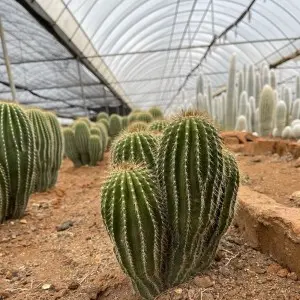Cacti are unique and fascinating plants that have evolved to survive in some of the harshest and driest environments on Earth. These prickly plants possess a remarkable ability to withstand extreme drought conditions, making them both iconic and admirable. In this article, we will delve into the world of cacti and explore why they don't die of thirst.
One of the most distinctive features of cacti is their succulent stems. Unlike most plants that rely on their leaves for photosynthesis, cacti have evolved to store water in their thick and fleshy stems. These stems act as reservoirs, allowing cacti to store large amounts of water during times of rain or high humidity. This built-in water storage system enables cacti to survive long periods of drought, as they can tap into these reserves when water is scarce.
Furthermore, cacti have adapted their leaves to minimize water loss. Unlike the broad and leafy structures found in most plants, cacti have developed modified leaves called spines. These spines serve multiple purposes, one of which is reducing water loss through transpiration. By having fewer and smaller surface areas exposed to the atmosphere, cacti can conserve the limited water they have.
In addition to their remarkable water storage capabilities, cacti have also developed unique physiological and anatomical adaptations to survive in arid conditions. For instance, cacti have specialized tissues called CAM (Crassulacean Acid Metabolism) that allow them to carry out photosynthesis at night, when the temperature is cooler and the risk of water loss through evaporation is lower. This nocturnal photosynthesis helps cacti conserve water during the day, when the scorching sun could quickly deplete their water supplies.

Moreover, cacti have a shallow and widespread root system that enables them to quickly absorb any available moisture from the soil. These shallow roots spread horizontally rather than deeply, allowing the plants to capture water from a larger surface area. This adaptation allows cacti to make the most of even the smallest rainfall or dew, effectively maximizing their water intake.
Interestingly, cacti are also masters of reducing their overall water loss through a process called crassulacean acid metabolism. CAM plants, such as cacti, open their stomata at night to capture carbon dioxide, minimizing water loss during the hottest parts of the day.
In conclusion, cacti have evolved a multitude of adaptations that enable them to thrive in arid environments and avoid dying of thirst. Their succulent stems store water reserves, their modified leaves reduce water loss, their CAM photosynthesis allows for nighttime carbon dioxide capture, and their shallow roots maximize water absorption. These remarkable adaptations showcase the resilience and survival instincts of cacti, making them true champions of drought tolerance. Next time you come across a cactus in the desert, take a moment to appreciate the extraordinary adaptations that allow it to endure and flourish in a seemingly inhospitable environment.
Post time: Aug-31-2023